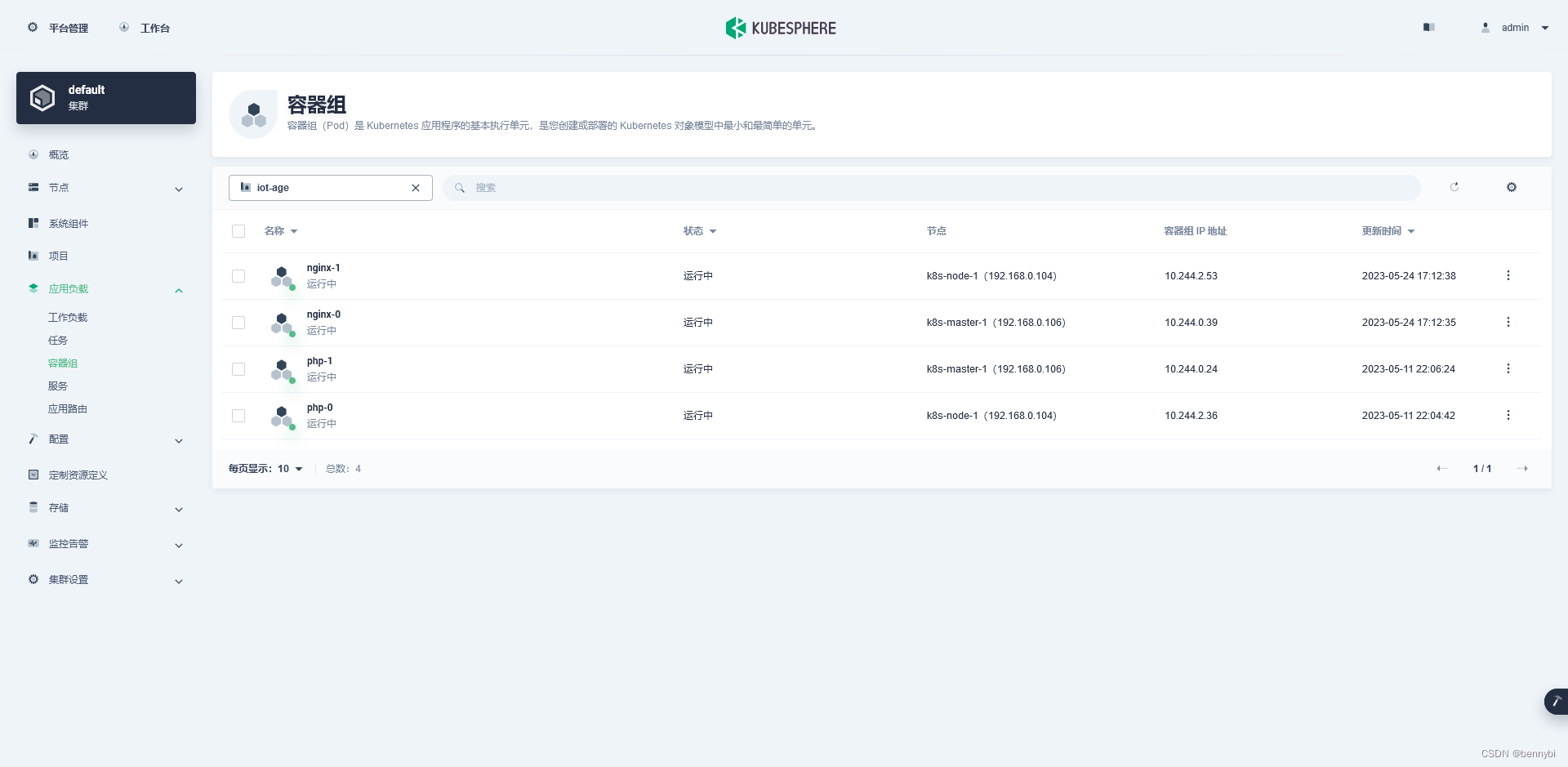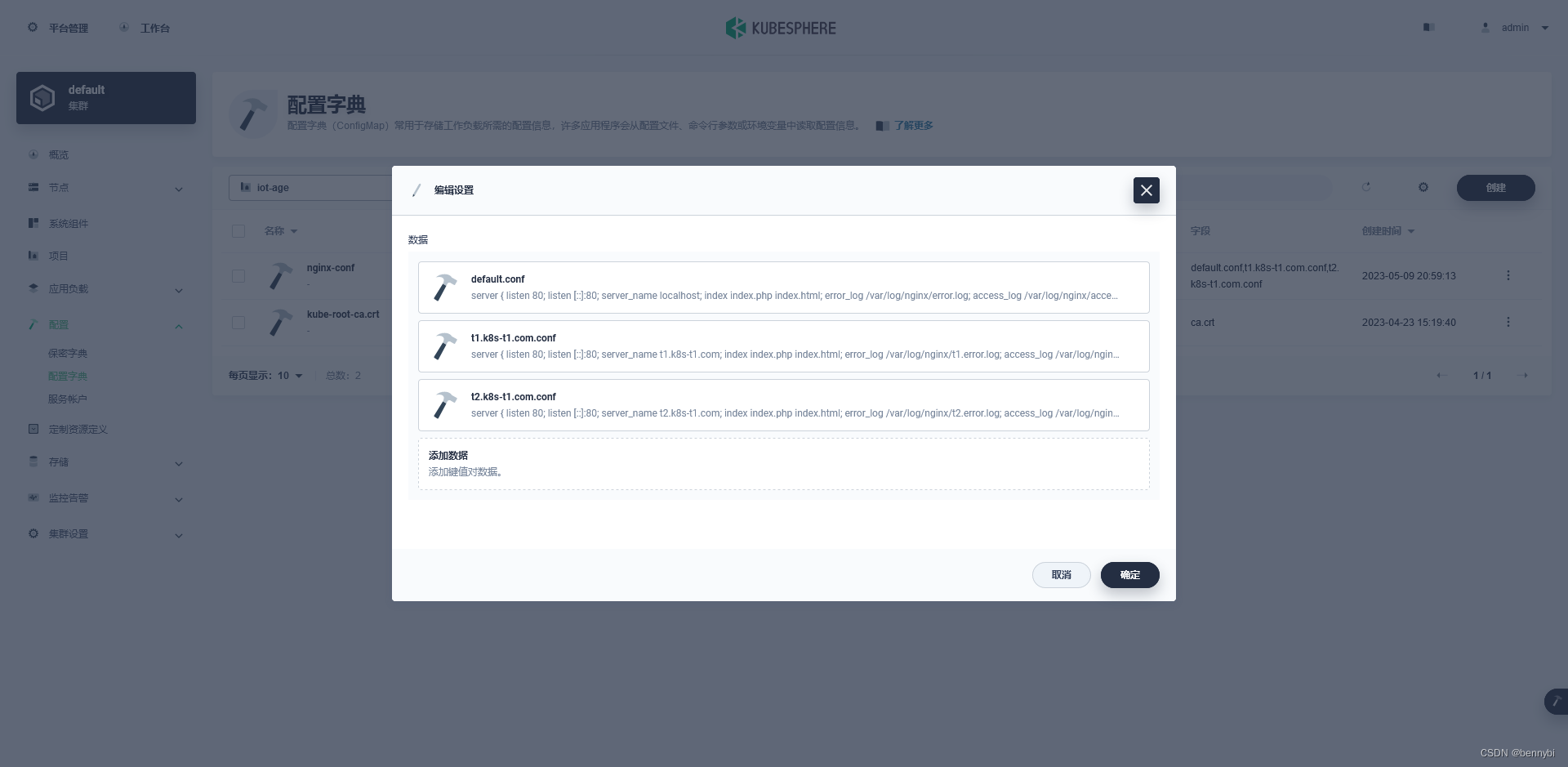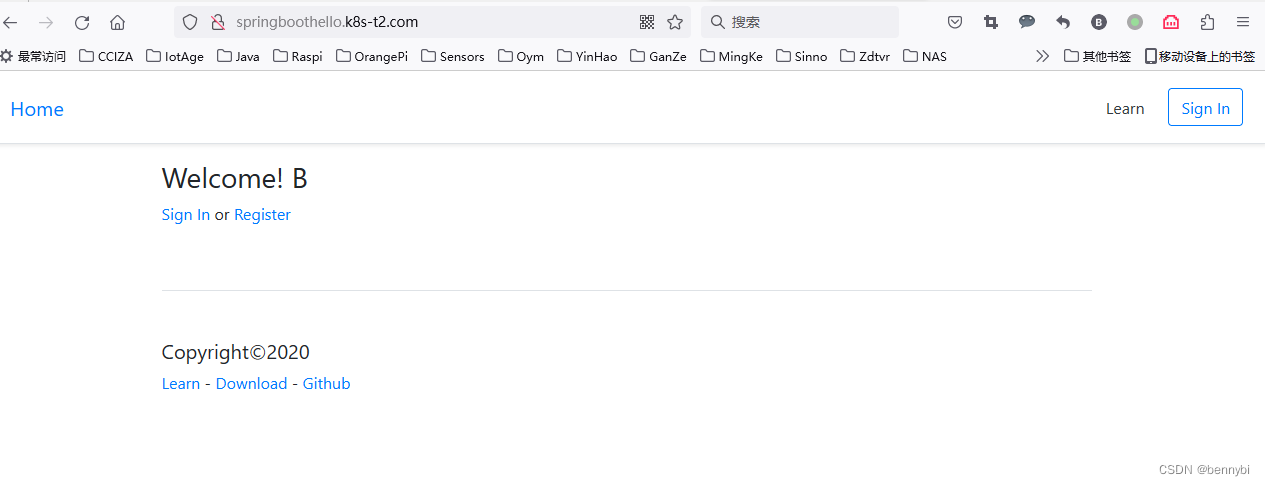
香橙派4和树莓派4B构建K8S集群实践之六:App服务部署
- 根据之前的k8s基础,我打算设置两种不同的虚拟主机运行在这个K8s集群上面,一个是PHP+Nginx体系的WebApp,一个是Java SpringBoot体系的WebApp。- 关于PHP+Nginx体系的WebApp,这里将实践两种部署模式:单节点多容器模式多节点单容器协作模式
目录
1.1 关于PHP+Nginx体系的WebApp,这里将实践两种部署模式:
3.1 在VS Code创建一个springboot-hello项目
1. 说明
- 根据之前的k8s基础,我打算设置两种不同的虚拟主机运行在这个K8s集群上面,一个是PHP+Nginx体系的WebApp,一个是Java SpringBoot体系的WebApp。
1.1 关于PHP+Nginx体系的WebApp,这里将实践两种部署模式:
- 单节点多容器模式 A - 即跨容器的设计模式,目的是在单个主机上运行多个具有超亲密关系的容器(进程),因此容器管理系统需要将其作为一个原子单位进行统一调度。Kubernetes编排系统设计的Pod概念就是该设计模式的实现之一。
- 多节点单容器协作模式 B - 将分布式应用(eg:nginx, php, mariadb...)的每个实例分布于多个节点,分别以单节点模式运行
1.2 配置清单
- wwwroot 是之前做pvc定义的文件目录,形如:/data0/nfs/iot-age-wwwroot-pvc-202ba85a-fd3f-4817-98ea-6764f9ec0d55
| 模式 | 主机域名 | 体系 | 指向hosts ip | 项目存放路径 |
| A | phpmyadmin.k8s-t2.com | PHP | 192.168.0.106 | /var/www/app |
| B | t1.k8s-t1.com | PHP | 192.168.0.106 | wwwroot/t1 |
| B | t2.k8s-t1.com | PHP | 192.168.0.106 | wwwroot/t2 |
| A | springboothello.k8s-t2.com | Java | 192.168.0.106 | /app.jar |
2. PHP+Nginx体系的WebApp部署
2.1 单节点多容器模式A
2.1.1 准备工作
以广为人知的phpmyadmin为示范app, 首先用buildkit工具打包成镜像,并上传到 hub.docker.com (这是我的镜像链接 https://hub.docker.com/repository/docker/bennybi/phpmyadmin/general) 。
buildctl build \
--frontend=dockerfile.v0 \
--local context=. \
--local dockerfile=. \
--export-cache type=inline \
--output type=image,name=docker.io/bennybi/phpmyadmin:v1,push=trueDockerfile
# This Dockerfile uses the latest version of the Bitnami PHP-FPM Docker image
FROM alpine:latest
# Copy app's source code to the /app directory
COPY . /app
# The application's directory will be the working directory
WORKDIR /app
2.2.2 部署
依据模式A的思想,模式A是用于快捷方便地部署单一应用,所以我把相关的设置都统一到 phpmyadmin.k8s-t2.com.yaml文件中定义, 其中规则:
- 项目名或domain需替换 "." 为 "-" 切换为部署名, 如phpmyadmin.k8s-t2.com => phpmyadmin-k8s-t2-com
- 容器中以刚才上传的镜像为initContainer,部署代码
- nginx, php-fpm为容器服务,nginx调用local-php-fpm:9000 解释php运行时逻辑
- 打包时,需在代码预先定义与数据库服务的连接,如:my-release-mariadb-galera.default,这里没做额外的configmap
# Service
apiVersion: v1
kind: Service
metadata:
name: phpmyadmin-k8s-t2-com
namespace: iot-age
spec:
type: ClusterIP
sessionAffinity: ClientIP
sessionAffinityConfig:
clientIP:
timeoutSeconds: 10800
ports:
- name: nginx
port: 80
protocol: TCP
targetPort: 80
selector:
app: phpmyadmin-k8s-t2-com
---
# deployment
apiVersion: apps/v1
kind: Deployment
metadata:
name: phpmyadmin-k8s-t2-com
namespace: iot-age
spec:
replicas: 2
selector:
matchLabels:
app: phpmyadmin-k8s-t2-com
template:
metadata:
labels:
app: phpmyadmin-k8s-t2-com
spec:
hostAliases:
- ip: "127.0.0.1"
hostnames:
- "local-php-fpm"
# 私有docker 镜像仓库
# imagePullSecrets:
# - name: registrykey-qlcoud-1
# 自定义设置POD的hosts
initContainers:
- name: app-php
image: "bennybi/phpmyadmin:v1"
imagePullPolicy: Always
# 复制php程序文件到wwwroot volume
command: ["sh", "-c", "cp -r /app /appdata"]
volumeMounts:
- mountPath: /appdata
name: wwwroot
containers:
#php-fpm php运行环境
- name: php-fpm
image: "bennybi/php-fpm:v1"
imagePullPolicy: IfNotPresent
volumeMounts:
- mountPath: /var/www
name: wwwroot
#webserver
- name: nginx
image: nginx
imagePullPolicy: IfNotPresent
resources: {}
terminationMessagePath: /dev/termination-log
terminationMessagePolicy: File
ports:
- containerPort: 80
volumeMounts:
- name: wwwroot
mountPath: /var/www
- name: nginx-conf
mountPath: /etc/nginx/conf.d/
#做一个emptyDir类型,名为wwwroot的volume 用于多个容器共享同一个挂载
volumes:
- name: wwwroot
emptyDir: {}
- name: nginx-conf
configMap:
name: phpmyadmin-k8s-t2-com.nginx-conf
---
kind: ConfigMap
apiVersion: v1
metadata:
name: phpmyadmin-k8s-t2-com.nginx-conf
namespace: iot-age
annotations:
kubectl.kubernetes.io/last-applied-configuration: >
{"apiVersion":"v1","data":{"default.conf":"server {\n listen
80;\n listen [::]:80;\n server_name localhost;\n \n index
index.php index.html;\n error_log /var/log/nginx/error.log;\n
access_log /var/log/nginx/access.log;\n root /var/www/html;\n
location / {\n try_files $uri $uri/ /index.php?$query_string;\n
}\n\n #location / {\n # #root /usr/share/nginx/html;\n #
root /var/www/html;\n # index index.php index.html
index.htm;\n #}\n \n location ~ \\.php$ {\n try_files $uri
=404;\n fastcgi_split_path_info ^(.+\\.php)(/.+)$;\n
fastcgi_pass local-php-fpm:9000;\n fastcgi_index index.php;\n
include fastcgi_params;\n fastcgi_param SCRIPT_FILENAME
$document_root$fastcgi_script_name;\n fastcgi_param PATH_INFO
$fastcgi_path_info;\n }\n\n error_page 500 502 503 504
/50x.html;\n location = /50x.html {\n root
/usr/share/nginx/html;\n
}\n}\n"},"kind":"ConfigMap","metadata":{"annotations":{},"name":"phpmyadmin-k8s-t2-com.nginx-conf","namespace":"iot-age"}}
data:
default.conf: |
server {
listen 80;
listen [::]:80;
server_name localhost;
index index.php index.html;
error_log /var/log/nginx/error.log;
access_log /var/log/nginx/access.log;
root /var/www/app;
location / {
try_files $uri $uri/ /index.php?$query_string;
}
#location / {
# #root /usr/share/nginx/html;
# root /var/www/html;
# index index.php index.html index.htm;
#}
location ~ \.php$ {
try_files $uri =404;
fastcgi_split_path_info ^(.+\.php)(/.+)$;
fastcgi_pass local-php-fpm:9000;
fastcgi_index index.php;
include fastcgi_params;
fastcgi_param SCRIPT_FILENAME $document_root$fastcgi_script_name;
fastcgi_param PATH_INFO $fastcgi_path_info;
}
error_page 500 502 503 504 /50x.html;
location = /50x.html {
root /usr/share/nginx/html;
}
}
---
# Ingress
apiVersion: networking.k8s.io/v1
kind: Ingress
metadata:
name: phpmyadmin-k8s-t2-com
namespace: iot-age
annotations:
kubernetes.io/ingress.class: nginx
nginx.ingress.kubernetes.io/affinity: cookie
nginx.ingress.kubernetes.io/session-cookie-name: stickounet
nginx.ingress.kubernetes.io/session-cookie-expires: "172800"
nginx.ingress.kubernetes.io/session-cookie-max-age: "172800"
spec:
rules:
- host: phpmyadmin.k8s-t2.com
http:
paths:
- path: /
pathType: Prefix
backend:
service:
name: phpmyadmin-k8s-t2-com
port:
number: 80
ingressClassName: nginx2.2.3 访问效果
2.2 多节点单容器模式B
2.2.1 准备工作
先在本地准备好两个t1,t2文件夹,里面各放置一个index.php
<?
echo "T1 Site is {$_SERVER['HTTP_HOST']} <br>";
phpinfo();<?
echo "T2 Site is {$_SERVER['HTTP_HOST']} <br>";
phpinfo();上传到设置表格描述的对应路径
当前容器组截图
2.2 配置虚拟主机
在KubeSphere后台,去 配置-》配置字典,在nginx-conf配置项中,点编辑设置
添加数据项,t1.k8s-t1.com.conf & t2.k8s-t1.com.conf
server {
listen 80;
listen [::]:80;
server_name t1.k8s-t1.com;
index index.php index.html;
error_log /var/log/nginx/t1.error.log;
access_log /var/log/nginx/t1.access.log;
root /var/www/html/t1;
location ~ .*\.(gif|jpg|jpeg|png|bmp|swf|flv|mp4|ico)$ {
expires 30d;
access_log off;
}
location / {
try_files $uri $uri/ /index.php?$query_string;
}
location ~ \.php$ {
try_files $uri =404;
fastcgi_split_path_info ^(.+\.php)(/.+)$;
fastcgi_pass php:9000;
fastcgi_index index.php;
include fastcgi_params;
fastcgi_param SCRIPT_FILENAME $document_root$fastcgi_script_name;
fastcgi_param PATH_INFO $fastcgi_path_info;
}
error_page 500 502 503 504 /50x.html;
location = /50x.html {
root /usr/share/nginx/html;
}
}完成后,需重启nginx pods, 可分别访问这两个域名验证结果

3. Java Springboot App 部署
3.1 在VS Code创建一个springboot-hello项目
注意几点:
- 安装docker desktop, 配合vscode开发工具使用
- 安装vscode插件:Docker/Docker Exploer/Docker Extension Pack
3.2 制作App镜像
修改pom.xml,并输出App
<project xmlns="http://maven.apache.org/POM/4.0.0"
xmlns:xsi="http://www.w3.org/2001/XMLSchema-instance"
xsi:schemaLocation="http://maven.apache.org/POM/4.0.0 http://maven.apache.org/xsd/maven-4.0.0.xsd">
<parent>
<groupId>org.springframework.boot</groupId>
<artifactId>spring-boot-starter-parent</artifactId>
<version>3.0.0</version>
</parent>
<modelVersion>4.0.0</modelVersion>
<groupId>com.itranswarp.learnjava</groupId>
<artifactId>springboot-hello</artifactId>
<version>1.0-SNAPSHOT</version>
<!-- <packaging>war</packaging> -->
<properties>
<maven.compiler.source>17</maven.compiler.source>
<maven.compiler.target>17</maven.compiler.target>
<java.version>17</java.version>
<pebble.version>3.2.0</pebble.version>
</properties>
<dependencies>
<dependency>
<groupId>org.springframework.boot</groupId>
<artifactId>spring-boot-starter-web</artifactId>
</dependency>
<dependency>
<groupId>org.springframework.boot</groupId>
<artifactId>spring-boot-starter-tomcat</artifactId>
<scope>provided</scope>
</dependency>
<dependency>
<groupId>org.springframework.boot</groupId>
<artifactId>spring-boot-devtools</artifactId>
<scope>provided</scope>
</dependency>
<dependency>
<groupId>org.springframework.boot</groupId>
<artifactId>spring-boot-starter-jdbc</artifactId>
</dependency>
<!-- 集成Pebble View -->
<dependency>
<groupId>io.pebbletemplates</groupId>
<artifactId>pebble-spring-boot-starter</artifactId>
<version>${pebble.version}</version>
</dependency>
<!-- JDBC驱动 -->
<dependency>
<groupId>org.hsqldb</groupId>
<artifactId>hsqldb</artifactId>
</dependency>
</dependencies>
<build>
<finalName>app</finalName>
<plugins>
<plugin>
<groupId>org.springframework.boot</groupId>
<artifactId>spring-boot-maven-plugin</artifactId>
</plugin>
<!-- Docker maven plugin -->
<plugin>
<groupId>com.spotify</groupId>
<artifactId>docker-maven-plugin</artifactId>
<configuration>
<imageName>${project.artifactId}</imageName>
<imageTags>
<tag>1.0.0</tag>
</imageTags>
<dockerDirectory>src/main/docker</dockerDirectory>
<resources>
<resource>
<targetPath>/</targetPath>
<directory>${project.build.directory}</directory>
<include>${project.build.finalName}.jar</include>
</resource>
</resources>
</configuration>
</plugin>
<!-- Docker maven plugin -->
</plugins>
</build>
</project>在项目根目录下编写Dockerfile
FROM schnell18/zulu-java:alpine-jdk17-arm64-0.1.1
ADD ./target/app.jar /app.jar
ENTRYPOINT ["java","-jar","app.jar"]连接上自己的注册仓库,推送hub.docker.com,如图:

3.3 部署
springboothello.k8s-t2.com.yaml
# Service
apiVersion: v1
kind: Service
metadata:
name: springboothello-k8s-t2-com
namespace: iot-age
spec:
type: ClusterIP
#type: NodePort
sessionAffinity: ClientIP
sessionAffinityConfig:
clientIP:
timeoutSeconds: 10800
ports:
- port: 80
#nodePort: 30301
protocol: TCP
targetPort: 8080
selector:
app: springboothello-k8s-t2-com
---
# deployment
apiVersion: apps/v1
kind: Deployment
metadata:
name: springboothello-k8s-t2-com
namespace: iot-age
spec:
replicas: 2
selector:
matchLabels:
app: springboothello-k8s-t2-com
strategy:
rollingUpdate:
maxSurge: 25%
maxUnavailable: 25%
type: RollingUpdate
template:
metadata:
labels:
app: springboothello-k8s-t2-com
spec:
containers:
- image: bennybi/springboothello:latest
imagePullPolicy: Always
name: springboothello-k8s-t2-com
ports:
- containerPort: 8080
protocol: TCP
resources:
limits:
memory: 512Mi
cpu: "1"
requests:
memory: 512Mi
cpu: "1"
restartPolicy: Always
terminationGracePeriodSeconds: 30
---
# Ingress
apiVersion: networking.k8s.io/v1
kind: Ingress
metadata:
name: springboothello-k8s-t2-com
namespace: iot-age
annotations:
kubernetes.io/ingress.class: nginx
nginx.ingress.kubernetes.io/affinity: cookie
nginx.ingress.kubernetes.io/session-cookie-name: stickounet
nginx.ingress.kubernetes.io/session-cookie-expires: "172800"
nginx.ingress.kubernetes.io/session-cookie-max-age: "172800"
spec:
rules:
- host: springboothello.k8s-t2.com
http:
paths:
- path: /
pathType: Prefix
backend:
service:
name: springboothello-k8s-t2-com
port:
number: 80
ingressClassName: nginx访问截图:

4. 会话Session保持设置
这是当使用phpmyadmin时,遇到错误:
Failed to set session cookie. Maybe you are using HTTP instead of HTTPS to access phpMyAdmin.
我很快意识到这是由于访问请求被分配到不同的php pods上处理,而导致的session不同步引起的,解决办法:设置 ingress, nginx service, php service会话保持(即相同client ip的访问分配到相同pod, 有过期时间)
nginx.yaml
...
spec:
type: ClusterIP
sessionAffinity: ClientIP
sessionAffinityConfig:
clientIP:
timeoutSeconds: 10800php.yaml
...
spec:
type: ClusterIP
sessionAffinity: ClientIP
sessionAffinityConfig:
clientIP:
timeoutSeconds: 10800ingress-nginx.yaml
...
metadata:
name: ia-web-service1
namespace: iot-age
annotations:
kubernetes.io/ingress.class: nginx
nginx.ingress.kubernetes.io/affinity: cookie
nginx.ingress.kubernetes.io/session-cookie-name: stickounet
nginx.ingress.kubernetes.io/session-cookie-expires: "172800"
nginx.ingress.kubernetes.io/session-cookie-max-age: "172800"5. 遇到的问题
-不能用软链方式访问项目目录,在找解决办法
6. 参考
- Kubernetes的Pod研究(3)--Pod设计模式和生命周期_wx6325de70699f3的技术博客_51CTO博客
- 聊聊如何在K8S中实现会话保持_k8s service 会话保持_linyb极客之路的博客-CSDN博客
更多推荐
 已为社区贡献1条内容
已为社区贡献1条内容










所有评论(0)